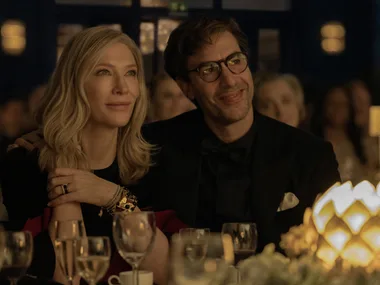Australia story
Darwin
When Baz Luhrmann came to town to recreate the bombing of Darwin for his movie Australia, some the locals thought the city was under attack again. As the cameras rolled, the sound of huge explosions and WWII aircraft bombing the harbour echoed up the hill and along the CBD’s Esplanade, bringing startled locals to Stokes Hill Wharf in record numbers.
Australia’s number one movie location in Darwin, Stokes Hill Wharf, is also a popular place to come for an evening out at some of the restaurants and bars that overlook the harbour. Like Mindil Beach and its market on the other side of town, the wharf is a great place to meet friends and enjoy the cool evening sea breezes.
Visitors to Australia’s fastest growing city can take a cruise to the wharf on the pearl lugger Anniki, a boat used in several of the film’s scenes. Nicole Kidman spent several days on board portraying the intrepid English aristocrat, Lady Sarah Ashley, on a mission to save a party of children stranded on island. Another scene filmed at the Wharf was Lady Sarah’s arrival in the Territory on board a Catalina seaplane, after inheriting a cattle station.
In his book Hell West and Crooked, Tom Cole described Darwin as “a kaleidoscope of every creed and colour … buffalo hunters rubbed shoulders with pearlers; gold miners swapped yarns with cattlemen”.
Today, the city is just as colourful. The pearl divers have moved on, but cattlemen and gold miners still mingle with many other equally colourful characters.
Dreamtime
Hawk Dreaming, Kakadu
It comes as no surprise to see a wedge-tailed eagle soaring above “Big Bill’s Place”. Its other name is, after all, Hawk Dreaming. Bordered by ancient outcrops of red sandstone and a network of lush green billabongs, this enclave is one of the Northern Territory’s best-kept secrets, a gem of a place that gives visitors an insider’s view of this World Heritage-listed national park.
Located on the traditional land of the late “Big Bill” Neidjie, Kakadu’s legendary Gagadju elder, Hawk Dreaming is the base of AAT Kings/Aussie Adventures small-scale tours. With only eight tents, a wash block and a lodge (with dining room and comfortable library/lounge), this is how Big Bill wanted it – small (a maximum of 16 guests), intimate and far from the crowds of “Kakadu central”. Close to Arnhemland, this safari-style camp couldn’t be better placed to visit Kakadu’s highlights. From here, the three-day guided tour takes guests to Barramundi Gorge in the south of the park, the Aboriginal art galleries at Ubirr Rock and the magnificent Jim Jim Falls, where, during the Dry, you can laze on beaches of fine white sand and swim in crystal clear lakes. Then there are the spectacular flood plains around Cannon Hill, a picnic on the leafy banks of the East Alligator River, a visit to a six-metre high cathedral termite mound and a cruise on Yellow Waters at Cooinda.
Just as you think the day is over, there’s the sunset stroll back at Hawk Dreaming, where, on the right day, the waters of the billabong turn gold and crimson as the resident four-metre croc glides by on his last patrol of the day. All in all, this is one of the Top End’s top treats. Affordable at $895 for three days (all meals included), the camp is comfortable and chic, the meals freshly prepared and hearty. Yet most of all, the guests love the camp’s peace and seclusion, just as Big Bill would have wanted.
Visit: www.aussieadventures.com.au
On Safari
Bamurru Plains, Mary River
This lodge gives adventure seekers a taste of understated luxury and the option of going on an African-style safari Down Under. Located next to Kakadu, Bamurru Plains sits on a peninsula in the middle of a flood plain, a wildlife haven with hundreds of thousands of migratory birds, the world’s largest estuarine crocodiles, Asian buffalo, Indian sambar deer, wild boar, agile wallabies and flocks of flying foxes that fill the sky at sunset. It offers “wild bush luxury” in a region that during the Wet has been compared with Botswana’s Okavango Delta. Built on stilts, the lodge is flanked by silvery-green paperbark forests and billabongs, and is the brainchild of Africa aficionado Charles Carlow, heir to British aristocrat Lord Portarlington.
Elegantly minimalist in design and built with a mix of hardwood and hi-tech industrial materials, the spacious open-plan lodge (with dining area, bar, kitchen and sitting room) has a large deck with an infinity-edge pool overlooking the flood plain, where the animals come to drink.
Several of the lodge walls are made of see-through aluminium mesh that bring the outside in – without the insects. The villas, also on stilts, have stylish bathrooms with treehouse-style interiors.
The service is warm and an on-site chef produces five-star cuisine, including brunch, a light lunch and a three-course dinner each day. The pre-dinner prawns, scallops and crocodile canapés set the scene.
Spend your days in an airboat skimming over the flood plain past countless birds, cruise along crocodile-infested rivers, watch herds of buffalo amble past your villa at dawn, or cool off at day’s end in the infinity pool as inquisitive wallabies look on. Barramundi fishing trips and excursions to Aboriginal rock art sites can be organised on booking.
Visit: www.bamurruplains.com
Fisherman’s paradise
Peppers Seven Spirit Bay, Coburg Peninsula
Seven Spirit Bay is a place of colour, a remote coast of rainbow cliffs, where sedimentary rocks of turmeric yellow, caramel and chilli red earth rise above the turquoise waters of the Timor Sea. As the tide ebbs, slithers of white sand emerge from the bay. When it returns, shoals of fish leap from the water, their scales flashing silver in the sunlight.
Closer to Singapore than Sydney and just 11° south of the equator, Seven Spirit Bay is a remote outpost that attracts fishermen the world over. They come for the big game fish, flavoursome barra, wholesome jewfish, sweetly fleshed mangrove jack and succulent mud crabs.
It also has the enviable reputation of having Australia’s most northerly fine-dining restaurant, where the resort’s chefs serve exquisite food, as good as you’ll find in a big city. The chefs chief supplier is the sea, but you’ll also find dishes such as Harissa Spiced Lamb and Yogurt Dressing, Beef with Truffled Mash and Green Beans and Sweet Roasted Bangalow Pork Belly on the five-course nightly dinner menu.
Guests eat under the stars on a two-level deck overlooking a palm-shaded swimming pool and there’s also a terrace at the edge of the lawn overlooking the bay that’s perfect for pre-dinner cocktails.
The suites (called habitats) are octagonal in design and have six sides of louvered shutters. Each one is hidden in a hectare of tropical bushland. Each one has its own luxurious bathroom suite. Unfortunately, these are not attached to the sleeping villas but 20 metres along a paved path in bushland.
Nearby attractions include the ruins of Victoria Settlement, an ill-fated colonial outpost established in the 18th century.
Most guests come for the fishing, but those who prefer to stay at the lodge and be pampered can indulge in daily spa treatments and gentle nature walks around the resort.
Visit: www.peppers.com.au
Drover’s delight
Bullo River Station, Bullo River
Once the home of outback legend Sara Henderson, Bullo is the essence of a Top End cattle station. A place where a herd of 8000 Brahman-cross cattle graze on 250,000 hectares of grassy plain, while huge crocs cruise the large meandering rivers that run through the property.
Now run by Marlee Ranacher (the eldest daughter of the late Sara Henderson) and husband Franz, Bullo has become a legendary destination in its own right. On the north-east frontier of the Northern Territory, near the Western Australian border, the station is closer to the Kimberley and the little frontier town of Kununurra than Darwin, which is 90 minutes away by light plane.
Guests stay in an annexe with comfortable air-conditioned rooms with ensuite bathrooms and are served robust meals three times a day. There’s no such thing as a typical day at Bullo. Guests can visit Aboriginal rock art sites, picnic at pristine swimming holes, learn to crack a bull whip, ride, track wild buffalo or go croc spotting. As outback station experiences go, this is as authentic as it gets.
Visit: www.bulloriver.com
Ringside at Uluru
Longitude 131°, Uluru
This tented camp in the dunes around Uluru gives guests a dress-circle view of Australia’s iconic landmark. If you cant be bothered to get up and open the curtains in order to see the Rock at dawn, simply flick a bedside switch and the curtains slide apart. As the sun peers over the horizon, the great monolith begins to glow. Nothing but scrub and desert come between you and this sensational scene – except, maybe, your bank account.
At $1800 a night for a two-man “tent”, it’s a luxurious treat. Airport pick-ups, gourmet meals, fine wine and trips to Uluru are included. Each stylish suite is a self-contained glass and wooden cube suspended under a huge sail – with air-con, of course. From a distance, the 15 suites look like a string of mini Sydney Opera Houses. Beautifully appointed with bathrooms and king-size beds, each suite has a deck facing the Rock. At the main lodge, where meals are served, there’s a swimming pool, perfect for a dip before dinner.
Visit: www.voyages.com.au
Katherine Gorge
One of the Top End’s most spectacular Gorges can be found in the 292,000-hectare Nitmiluk National Park some 310km south of Darwin along the Stuart Highway. In reality, Katherine Gorge consists of several interconnected canyons and can be explored along hiking trails, by hiring a kayak or joining a cruise. Aboriginal-owned Nitmiluk Tours offers superb cruises along two or five of the 13 gorges on comfortable aluminium barges with fascinating commentaries by Aboriginal guides. One of the best cruises sets off in the late afternoon and serves a superb three-course dinner with wine and beer. It includes an easy walk between gorge one and two, plus a visit to a sandy beach and a return in the dark when the gorge walls are beautifully lit by spotlights. Visit: www.nitmiluktours.com.au
Croc-spotting on the Victoria River
Situated in the Gregory National Park between Katherine in the Northern Territory and Kununurra in WA’s Kimberley, the Victoria River ranks among one of world’s last great wild rivers and is chock-a-block with huge crocs. Geoff Pike and his wife, Beverley, have been taking tourists up the river for 12 years to enjoy the iconic Kimberley landscape and to spot those huge six-metre salties. Based at Timber Creek on the Victoria Highway, Geoff and Beverley take their visitors to Big Horse Creek and then along the great river towards the Joseph Bonaparte Gulf. “Our cruise is the closest you’ll get to giant crocs in the NT,” says Geoff. “We get the boat to within a few metres of these crocs lying on the mudflats along the river bank.
In fact, you get so close to these monsters you can see rivelets of moisture running from their tear ducts. Geoff’s boat cruises along at 55kph, but its two 200hp engines can reach a top speed of 76kph.
Tiwi Islands
Eighty kilometres north of Darwin in the turquoise waters of the Arafura Sea are the two Tiwi Islands, known as Melville and Bathurst. Just 35 minutes away from Darwin by light plane, these islands support two communities of Tiwi Islanders, several art galleries and freshwater swimming holes, waterfalls and wonderful off-shore fishing. Ideal to visit on a day tour, it’s also possible to stay longer at one of the island resorts, such as the three-star Munupi Wilderness Lodge on Melville island.
Bathurst Island is famous not only for the historic buildings and church established by a Catholic mission in 1911, but also for the Tiwi Island Tea Ladies, who not only serve traditional billy tea and damper, but also lay on traditional dances, with faces painted, and adorned in colourful dresses made from locally printed fabrics.
Visit: www.aussieadventure.com.au
Lord Kakadu and Arnhemland Safaris
Join one of legendary Sab Lord’s unforgettable safaris. Sab will tailor a 4WD tour to wherever you want to go. You sleep in comfort in a bed under canvas and eat under the stars, or he’ll drive you from lodge to lodge via spectacular sights.
Visit: www.lords-safaris.com
Barramundi Nature Lodge, Arnhemland
A fisherman’s paradise close to the Aboriginal art town of Maningrida. High on a ridge, it overlooks the floodplain, where the Liverpool River joins the Arafura Sea. Canvas suites on concrete slabs and utilitarian en-suite bathrooms are located in the bush and surround a lodge with a kitchen, dining room and bar. Popular among companies interested in sending their executives on incentive trips. Will only suit keen fisher folk and not those in search of life’s little luxuries and pampering.
Visit: www.barralodge.com.au
Where to Stay
Northern Territory
Darwin Airport Resort
Set among lush tropical gardens next to a wetland, this hotel/resort is built around beautiful landscaped gardens with swimming pool, spa area, bar and award-winning restaurant. Designed like a Balinese resort, it must be one of Australia’s most spectacular airport properties. And it’s only a seven-minute drive from the Esplanade that overlooks the bay.
Price: Standard room, from $160.
Where: 1 Henry Wrigley Drive, Marrara.
www.darwinairportresort.com.au
Bullo River Station
Welcome to life on an iconic outback cattle station made famous by author, the late Sara Henderson. Run by her daughter and son-in-law Marlee and Franz Ranacher, Bullo offers a purpose-built guest area next to the homestead with 12 double room with aircondition and ensuite facilities. Drinks and informal dinners are held on the terrace or in the homestead’s dining room. Guests can learn how to muster cattle, fish for barramundi, go croc-spotting or visit a pristine water hole and swim. It’s possible to fly in a small charter plane from Darwin or Kununurra as the station has an airstrip on the front lawn!
Price: Rooms and full board, from $750 a night.
Where: Off the Victoria Highway, 800kim from Darwin, NT, and 200km from Kununurra, WA.
www.bulloriver.com
Bowen
Coral Cove Apartments
These swish modern apartments are located on the beach overlooking the Coral Sea in a secluded spot a little out of town. With large balconies facing west (sunset), the one, two and three-bedroom apartments are modern, very stylish and come with large balconies and well-equipped kitchens. A few minutes walk is Horseshoe Bay, Hugh Jackman’s favourite beach when Baz Luhrmann brought the film unit of Australia to town. On the lawn, overlooking the beach, is The Cove International Restaurant that serves three meals a day with Asian fusion cuisine in the evening.
Price: From $210 a night for one-bed apartments
Where: Horseshoe Bay Road, Grays Bay.
www.coralcoveapartments.com.au
Tel: (07) 4791 2000
Big4 Coral Coast Holiday Park
Absolute beachfront villas on a palm-shaded lawn with cabanas on the water’s edge.
Price: Beachfront villas, from, $125 a night.
Where: Queens Bay.
www.big4.com.au
Kununurra, Western Australia
The Kimberley Grande
Easily the grandest place to stay in Kununurra, this property looks as if it is built from sandstone, but in fact, its walls are made from a clever composite material. The stylish, spacious rooms and suites overlook boab trees and a swimming pool. There’s a bar, popular with locals, and a restaurant that serves good quality meals. Owned by Marilynne Paspaley, of the pearling dynasty, the Grande has sister properties in Broome.
Price: Rooms from $187 a night; spa suites, from $336 a night.
Where: 20 Victoria Highway, Kununurra.
www.pinctada.com.au
El Questro Wilderness Park
Almost two hours west of Kununurra on the Old Gibb River Road, El Questro is located in the spectacular Cockburn Range, a pivotal location in the filming of Baz Luhrmann’s Australia, and a remarkable place to get a taste of what Kimberley wilderness has to offer. Guests can either stay at the camp site or air-conditioned villas overlooking the Pentecost River at the Station Homestead, at tented cabins at Emma Gorge (a 45-minute walk from a 30-metre waterfall and huge natural swimming pool) or at the exclusive Homestead, overlooking the Chamberlain Gorge.
What’s on offer: Trekking tours through spectacular wilderness areas, swimming at waterholes, barramundi fishing, 4WD tours, riding, scenic air tours and much more.
Price: Camping from $15 a night; Emma Gorge Tented Cabins, from $256 a night; Homestead from $1900 a night.
www.elquestro.com.au
Newsletter conversion description. Get the latest in your inbox.




















































.jpg?resize=380%2C285)








